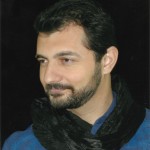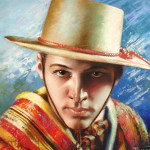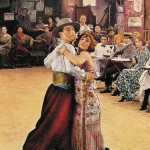Tango with a Star
Film Review by Ozgur Pamukcu

Rudolph Valentino in The Four Horsemen of the Apocalypse

Last night, at the opening of this year’s San Francisco Silent Film Festival, I had the rare opportunity to meet Rudolph Valentino for the first time in my life. He was in his prime, sexy and dashing, as he danced across the screening, dressed as an Argentine gaucho, and seducing every woman (and a few men) in the room with his smoldering good looks. Of course I mean I saw him on the big Castro Theater screen, in a wonderful tinted 35mm print from Photoplay Productions, the preservation work of Kevin Brownlow. The experience of seeing this film in 35mm is markedly different that watching the same film in a digital form. The Castro Theater projectors have the unique ability to vary the speed of the projection, which is required by this film, and give us an experience so authentic that I didn’t mind the missing frames, scratched and film dirt that 35mm is heir to. It was an authentic silent film experience, with the accent on “film.”
Directed by Rex Ingram, the film has the ability to reach across nearly a century of time, to a modern audience. Its anti-war story may be a bit heavy-handed for today’s viewer, but the film, which features a cast of thousands and some of the finest silent screen actors, is amazing to watch on a large screen. What made the experience truly amazing was the wonderful live score played by The Mount Alto Motion Picture Orchestra. They captured the essence of the film, and all its rhythms, infusing tango music that was so popular during the time of the story, and of course, during the jazz age when the film was made. I have heard this group play for other films, and in my opinion, they truly understand the genre of the silent film and how to bring music to the wonderful silence that supports and lifts the performances. Last night they were in great form, bringing the audience to its feet at the end of the show.
Valentino’s famous dance in the night club at the beginning of the film, has been seen many times in fragment form. It’s probably the most famous clip of Valentino, and one of the most iconic silent film clips known to modern audiences. But until you’ve seen the whole sequence, and watched him dance, you have never seen Valentino at his best. To make a living, Valentino had worked as a taxi dancer. Yes, like a dime-a-dance girl, but he was paid by women to trip the light fantastic across the dance floor. All of this happened before he was a star, of course. His dancing is elegant, like Fred Astaire, but with incredible sexuality. His intense, hot close-us probably wilted the women of his time. Valentino’s effect on the audience last night was palpable, and elicited all kinds of verbal expression last night at the Castro Theater.
The Four Horsemen of the Apocalypse was made by Metro Pictures (later to become part of the famous Metro-Goldwyn-Mayer Studios) in 1921. Yes, that’s 93 years ago, and yet the film held the audience’s attention and fascination the way I imagine that audiences in 1921 were similarly impressed. Despite a few hammy performances which the audience enjoyed rather than mocked, people sat in rapt attention, without a complaint or disparagement of this old acting style. But it was the star, Valentino, that was the glue that held the film together. Discovered by the scenario writer June Mathis, who fought for Valentino, not a star at that time, Valentino commands the screen with a power that we all know as “being a true movie star.”
Valentino as a screen presence is undeniable. His acting is subtle and muted, very much like a modern performance, and contains very little in the way of theatrical gestures or faces. He acts very much with his eyes, which in silent films was paramount to informing the audience of the character’s inner feelings. He would certainly be able to fit in to modern film-making, and would probably be a star today. He certainly was a true star last night, shining a light from across time and space, and reminding us what true movie stars were and can be. I was certainly very pleased to “meet” him last night, if only in the dark, sitting in my seat at the wonderful old neighborhood movie palace, The Castro Theatre.
The San Francisco Film Festival and The Mount Alto Motion Picture Orchestra are to be commended for producing a wonderful event last evening. They both work very hard to bring us the kinds of experiences that might never be available to us in the modern world of movies and commerce. For just a few hours last evening, I felt as if I had been transported across time to 1921, sitting in a movie palace and watching this wonderful silent film unfold and wrap us in its magic.







